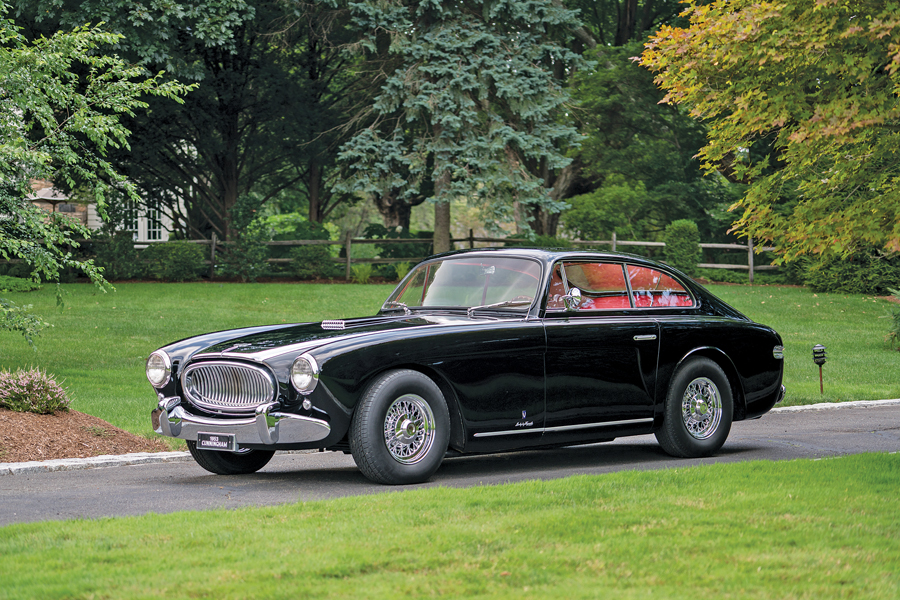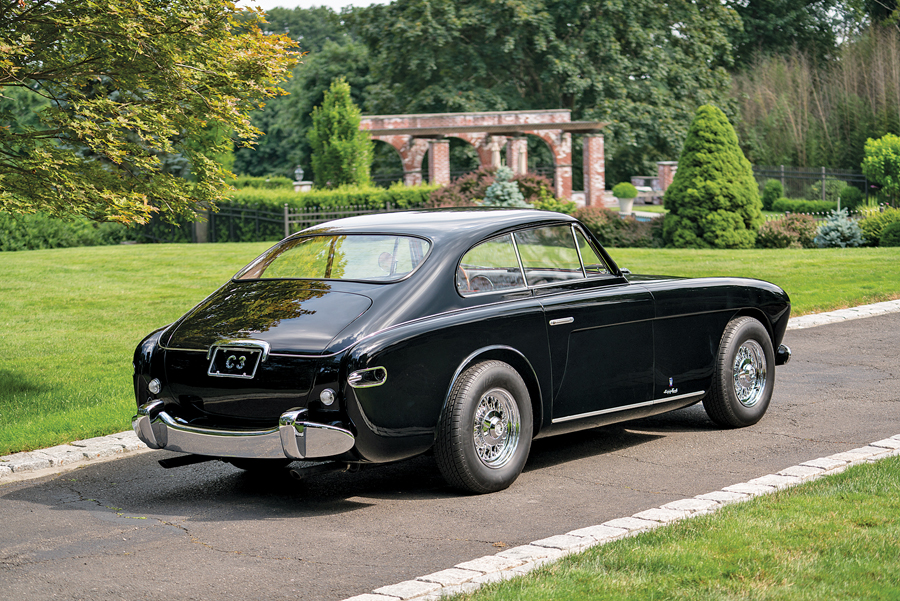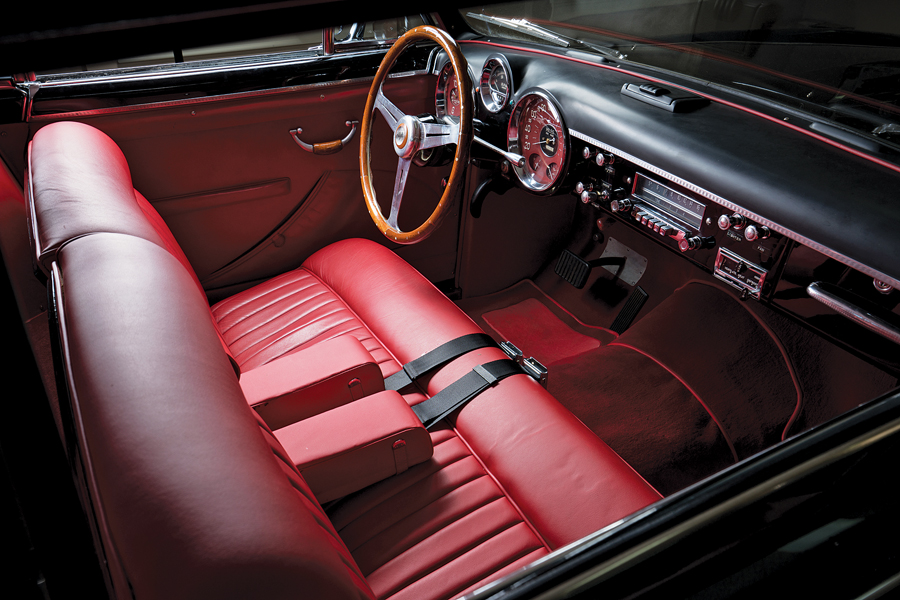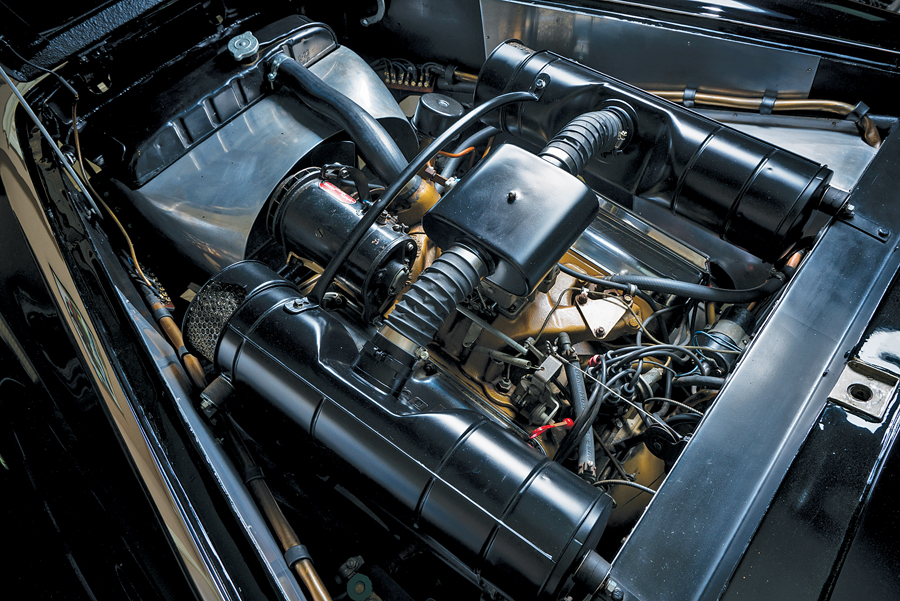- The personal car of Briggs Cunningham; retained by him and his family for 61 years
- One of just 25 Vignale-bodied C-3s produced
- A well-maintained original car, currently registering 10,097 miles
- Winner of the Historic Vehicle Association (HVA) National Automotive Heritage Award
- Researched by Cunningham historians Tom Cotter and Larry Berman
- The most significant extant C-3, with unbeatable provenance and originality.
SCM Analysis
Detailing
| Vehicle: | 1953 Cunningham C-3 coupe |
| Years Produced: | 1952–54 |
| Number Produced: | 27 |
| Original List Price: | $8,000 to $11,000, depending on options and body style |
| SCM Valuation: | $550,000 |
| Distributor Caps: | $50 |
| Chassis Number Location: | On left frame rail |
| Engine Number Location: | Left side of block |
| Website: | http://www.briggscunningham.com |
| Alternatives: | 1951–58 Pegaso Z-102, 1951–52 Ferrari 212, 1952 Ferrari 225 road car, 1948 Kurtis Sport Car |
| Investment Grade: | A |
This car, Lot 244, sold for $1,100,000, including buyer’s premium, at RM Sotheby’s auction in Monterey, CA, on August 19, 2017.
Briggs Cunningham had no intention of becoming an auto manufacturer. His dream was to stand on the winner’s podium at the 24 Heures du Mans, having achieved victory with American cars driven by American drivers.
But Le Mans organizers told him that if he wanted to homologate his race cars for the French classic, he was required to be a constructor — similar to Jaguar, Ferrari and Aston Martin — and build a minimum of 25 street cars.
So Briggs became a reluctant manufacturer of the Cunningham Continental, later renamed the C-3.
Building an American Le Mans racer
Initially the crew at B.S. Cunningham Company in West Palm Beach, FL, believed they could build the C-3 entirely in house, but after constructing an awkward-looking coupe and a roadster, they became convinced the bodies were far too difficult, expensive and time consuming to construct.
They built chassis, similar to those in the C-4R and C-4RK race cars that drove to victory at Watkins Glen, Sebring and Elkhart Lake, and sent them to Italy for bodies. The first 10 cars were built on a 105-inch wheelbase chassis, which was increased by two inches for the final 15 cars.
Chrysler 331-ci Hemi engines, with stock 2-barrel carburetion, were installed in the chassis. These engines produced 180 horsepower. Four-barrel carburetors were not yet available, so Cunningham’s craftsmen fabricated aluminum log manifolds with four single-barrel Zenith carbs. The resulting 220-horsepower engines were backed with 3-speed Cadillac manual gearboxes in the first four cars. All but one of the remaining C-3 cars got a semi-automatic, clutch-actuated Chrysler Fluidmatic transmission.
Running chassis were shipped to Torino, Italy, where Carrozzeria Vignale clothed them in a stunning Giovani Michelotti-designed aluminum and steel body.
The cars resemble a 1952 Ferrari 212, but 20% larger. Before they were shipped back to the United States, the cars were finished, usually in two- or three-tone paint schemes and trimmed in supple leather.
Twice the cost of a new Cadillac
Sales manager and lead team driver Phil Walters initially priced the C-3 convertibles at $8,000 and the coupes at $9,000, more than two times the cost of a new Cadillac. The cars were sold to wealthy enthusiasts such as Nelson Rockefeller and Mercury Marine owner Carl Kiekhaefer.
When a time-and-materials study was conducted, it showed the company was losing between $2,000 and $4,000 on each car sold — even after prices were increased.
A total of 25 cars were built between 1952 and 1954 and, interestingly, all 25 still exist today, more than 60 years later.
Our subject car, chassis 5223, was the 14th C-3 built and got a 107-inch wheelbase chassis.
Because it was Briggs Cunningham’s personal car, and was completed after C-3 production ended, it benefited from the use of later components.
Internal documents show the car was the only one built with the later, slightly higher-compression 1954 Chrysler Hemi engine, 4-barrel carburetor and fully automatic Powerflite 2-speed transmission.
This car remained in the Cunningham family for 61 years, and it was driven only 10,000 miles. It was first in the possession of Briggs’ first wife, Lucie Bedford Cunningham Warren, and the car was then passed to daughter Lucie Cunningham McKinney.
During McKinney’s ownership, it was repainted black and reupholstered red, as original, and gained a set of period chrome Chrysler wire wheels. Upon McKinney’s death, the car was sold to a private collector as part of a package that also included her C-3 convertible.
A sudden rise in values
For decades, Cunningham C-3s were underappreciated, trading in the high five figures up to the low six-figure range. But new C-3 owners have brought renewed enthusiasm and exposure to the brand.
At $1.1 million, this is the third C-3 to sell for seven figures. The third coupe built, chassis 5208, sold for $1.2 million at RM Sotheby’s 2016 Monterey auction. McKinney’s former convertible, chassis 5441, was traded privately for three cars plus cash — the equivalent of $1.35 million.
Well sold
If this car had been Enzo Ferrari’s or Carroll Shelby’s family car for 60 years, it would have sold for five or 10 times more.
But considering that Cunningham’s team placed 3rd in the 1953 Le Mans race — in a C5-R car — he never quite earned the same level of fame that Ferrari and Shelby enjoyed. So the $1.1 million realized for Briggs Cunningham’s personal C-3 was spot-on, well sold and well bought.
Hopefully the new owner is planning to bring this new purchase to the Greenwich Concours next June, where a planned Cunningham Owner’s Gathering will attempt to assemble all 25 C-3s on the lawn overlooking Long Island Sound. ♦
(Introductory description courtesy of RM Sotheby’s.)



